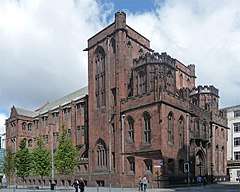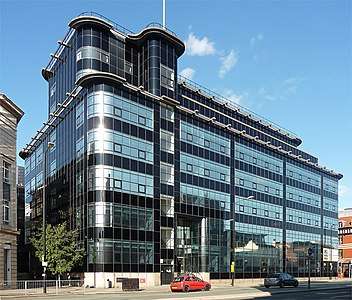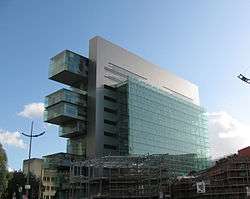Gorton Monastery
| Church and Friary of St Francis | |
|---|---|
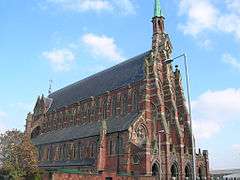 | |
 Shown within Greater Manchester | |
| Basic information | |
| Location |
Gorton, Manchester, England |
| Geographic coordinates | 53°28′5.9″N 2°11′15.0″W / 53.468306°N 2.187500°WCoordinates: 53°28′5.9″N 2°11′15.0″W / 53.468306°N 2.187500°W |
| Affiliation | Roman Catholic (Franciscan) |
| Ecclesiastical or organizational status | Friary |
| Status | Secular events venue |
| Website | www.themonastery.co.uk |
| Architectural description | |
| Architectural style | High Victorian Gothic architecture |
| Completed | 1872 |
The Church and Friary of St Francis, known locally as Gorton Monastery, is a 19th-century former Franciscan friary in Gorton, Manchester, England. The Franciscans arrived in Gorton in December 1861 and built their friary between 1863 and 1867. Most of the building work was done by the friars themselves, with a brother acting as clerk of works.[1] The foundation stone for the church was laid in 1866 and completed in 1872; it closed for worship in 1989.[2] It is a prominent example of High Victorian Gothic architecture,[2] and has been listed with Grade II* status since 1963. It was designed by Edward Welby Pugin (1834–1875), whose father, A.W.N. Pugin, promoted the revival of Gothic as the style of architecture which was the ideal expression of Roman Catholic faith and worship in church buildings.[3]
Modern developments
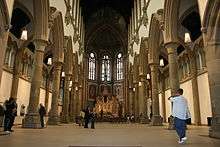
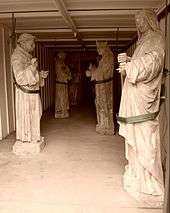
In 1997, Gorton Monastery was placed on the World Monuments Fund Watch List of 100 Most Endangered Sites in the World alongside Pompeii, the Taj Mahal and the Valley of the Kings.[4]
The church and associated friary buildings underwent a £6 million restoration programme supported by funds from the Heritage Lottery Fund, English Heritage and European Regional Development Fund.[5] The project was completed in June 2007 when the restored buildings opened as a venue for conferences, business meetings and community events.[6] The building is also used for a range of concerts.
Construction of a new "Welcome Wing" with facilities for education and the community, along with further restoration on the altars, decorations, and floor tiles,[7] started in February 2016,[8] following from a £1 million donation from Norman Stoller in September 2014, and £2 million from the Heritage Lottery Fund in December 2014.[7] The wing, designed by Eco Arc, was built by HH Smith & Sons Ltd on the footprint of a building that was demolished in the 1960s.[8]
See also
References
- ↑ Hartwell, C; Hyde, M.; Pevsner, N. (2004). The Buildings of England. Lancashire: Manchester and the South East. London: Yale University Press. p. 372.
- 1 2 "The History of Gorton Monastery". themonastery.co.uk. Retrieved 14 December 2007.
- ↑ Hill, Rosemary (2007). God's Architect: Pugin and the Building of Romantic Britain. Allen Lane. ISBN 978-0-7139-9499-5.
- ↑ "New threat to Gorton monastery". Manchester Evening News. 29 August 2007.
- ↑ "Before and after: historic buildings restored and transformed". The Daily Telegraph. 21 March 2013.
- ↑ "Gorton Monastery's £6 million restoration complete". North West Development Agency. Archived from the original on 18 November 2007. Retrieved 14 December 2007.
- 1 2 "Your chance to go inside the magnificent Gorton Monastery for free every Monday during February and March". Manchester Evening News. 1 February 2015.
- 1 2 "Restoration of Gorton Monastery continues as work begins on new £3 million wing". Manchester Evening News. 27 January 2016.
External links
| Wikimedia Commons has media related to Gorton Monastery. |

